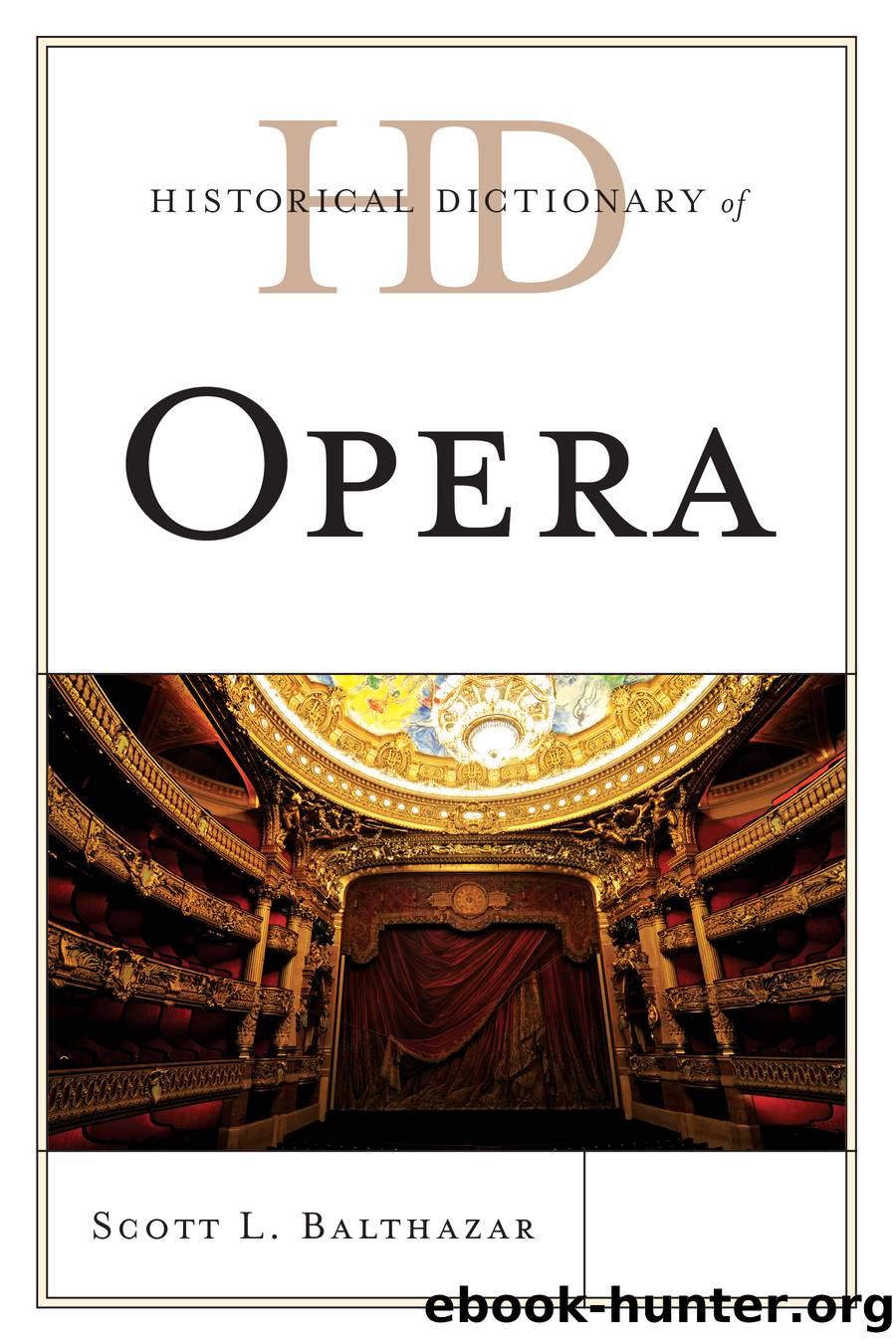Historical Dictionary of Opera by Balthazar Scott L

Author:Balthazar, Scott L.
Language: eng
Format: epub
Tags: undefined
Publisher: Scarecrow Press Inc.
Published: 2012-03-15T00:00:00+00:00
OPÃRA COMIQUE
Term applied by the late 19th century to French opera combining spoken dialogue and vocal and instrumental music, in contrast to opéra, which is set to music throughout (as is Italian opera buffa). It is reserved for works of greater artistic merit than the popular entertainments (including operettas) of the so-called boulevard theaters. And it encompasses an array of designations that were employed as the genre developed during the 18th and 19th centuries. At various points, âOpéra-Comiqueâ (distinguished by the hyphen) was also the name of companies or theaters that performed such works (see PARIS).
French opera with spoken dialogue originated in the theaters of the Parisian spring and summer trade fairs (the St. Germain and the St. Laurent), termed the Opéra-Comique after 1715, and the rival Comédie-Italienne or Nouveau Théâtre Italien (after 1716). Before 1750, their comédies en vaudevilles and opéras comiques en vaudevillesâspoken plays that incorporate songs adapting preexisting, often popular melodies to new texts (vaudevilles)âtraded in unsophisticated humor, social satire, and parody of the operas and plays of the official theaters (the Académie Royale de Musique, or Opéra, and the Comédie-Française). The first work to be designated âopéra comiqueâ was Alain-René Lesageâs (1668â1747) parody (1715) of André Destouchesâs (1672â1749) Télémaque et Calypso (1714).
Influenced by imported Italian intermezzos and opere buffe like those produced in Paris during the War of the Comedians (1752â54), and particularly by Jean-Jacques Rousseauâs Le devin du village, a French approximation of the Italian intermezzo that contained no spoken words, composers provided newly composed songs in the comédie mêlée dâariettes (play interspersed with little arias) or a combination of new and adapted songs in the comédie en ariettes et en vaudevilles. While most of these set pieces were simple songs resembling vaudevilles, by the 1760s others embraced a richer Italianate lyricism and even incorporated vocal display (for the female leads), and duets and larger ensembles sometimes occurred. Subject matter also became more varied, well mannered, and sophisticated, leading librettists to qualify comédie with descriptive modifiers: féerie (magical/fairy), chevaleresque (medieval knightly/chivalric), larmoyant (sentimental/tearful), and villageois (rustic). Leaders in this style of opéra comique were Egidio Duni; chess player and composer François-André Danican Philidor (famous for his Tom Jones, 1765, based on Henry Fieldingâs novel); André-Ernest-Modeste Grétry; and Nicolas-Marie Dalayrac (1753â1809, whose Nina, ou La folle par amour, 1786, was the source of Giovanni Paisielloâs Nina, 1789).
During the 1780s, serious subject matter appeared frequently, notably in Grétryâs Richard Coeur-de-lion (1784), as the lighthearted comédie mêlée dâariettes declined. This trend climaxed following the Revolution in the works of Luigi Cherubini and Ãtienne-Nicolas Méhul, in which imperiled protagonists confront violent situations in settings that range from Gothic to classical (e.g., Cherubiniâs Lodoïska, 1791, and Médée, 1797). They were designated as comédie héroïque, drame lyrique, drame mêlé de chants (drama interspersed with songs), fait historique (historical event, a recreation of a recent occurrence depicting the heroism of everyday people), or simply opéra. At this point the exception, truly comic operas often received the title opéra bouffon, particularly if they mimicked Italian opera buffa.
Download
This site does not store any files on its server. We only index and link to content provided by other sites. Please contact the content providers to delete copyright contents if any and email us, we'll remove relevant links or contents immediately.
Kathy Andrews Collection by Kathy Andrews(11326)
The remains of the day by Kazuo Ishiguro(8395)
Paper Towns by Green John(4800)
Spare by Prince Harry The Duke of Sussex(4788)
Industrial Automation from Scratch: A hands-on guide to using sensors, actuators, PLCs, HMIs, and SCADA to automate industrial processes by Olushola Akande(4604)
The Body: A Guide for Occupants by Bill Bryson(4585)
Be in a Treehouse by Pete Nelson(3648)
Machine Learning at Scale with H2O by Gregory Keys | David Whiting(3627)
Harry Potter and the Goblet Of Fire by J.K. Rowling(3609)
Never by Ken Follett(3528)
Goodbye Paradise(3446)
The Remains of the Day by Kazuo Ishiguro(3139)
Into Thin Air by Jon Krakauer(3131)
The Cellar by Natasha Preston(3077)
The Genius of Japanese Carpentry by Azby Brown(3040)
Fairy Tale by Stephen King(2949)
120 Days of Sodom by Marquis de Sade(2941)
Drawing Shortcuts: Developing Quick Drawing Skills Using Today's Technology by Leggitt Jim(2940)
The Man Who Died Twice by Richard Osman(2808)
